Guttural Toads and other frogs have been galvanised into springtime activity by sprinklings of early season rain. The males have been calling for mates culminating in pairs spawning in our pond.
Most noticeable are the Guttural Toads (Sclerophrys gutturalis) due to their loud nocturnal calls during their breeding times and because they are the largest and least shy amphibians in our garden. Like many toad species in southern Africa, Guttural Toads are explosive breeders: they breed in response to specific trigger factors. Breeding is triggered by rain in the early spring and possibly also by rising temperatures for those near permanent bodies of water. Breeding events triggered by rain may take place through to mid-summer.
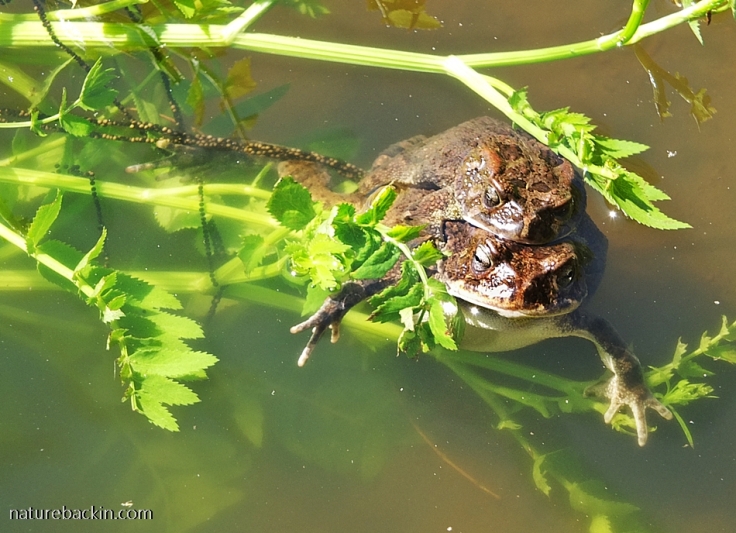
After a rowdy night, these Guttural Toads were busy spawning in the pond in the early morning. Their spawn can seen behind them in the form of two gelatinous strings of eggs that the pair of toads wind around the vegetation as they swim
In our garden, the loud calling from the Guttural Toads, which starts after sundown – and may continue for several hours – lasts only a few nights until the next trigger for the next breeding event. So for those who object to the sounds of calling toads, in our experience at least, the calling periods are sporadic. During the day Guttural Toads take shelter in shady and concealed spots, such as under leaves and logs, with some excavating small burrows in soft ground.
Worldwide, amphibians are decreasing in number. Of the 117 species of frogs and toads found in South Africa, 51 species are endemic. In 2010, of these, 8 species were classed as being Critically Endangered, 16 species as Endangered, 16 as Vulnerable and 8 species Near Threatened. Habitat loss is one of the major threats facing amphibians.
The Guttural Toad is not one of the species endemic to southern Africa and it occurs naturally as far north as southern Somalia. In South Africa it has adapted well to artificial bodies of water such as dams and ponds, even in urban areas. Its range has extended into the south-west, probably because of inadvertent translocation by people, and it is considered a threat to the Leopard Toad that is endemic to that region. Consequently, in the South Western Cape they are subjected to eradication.
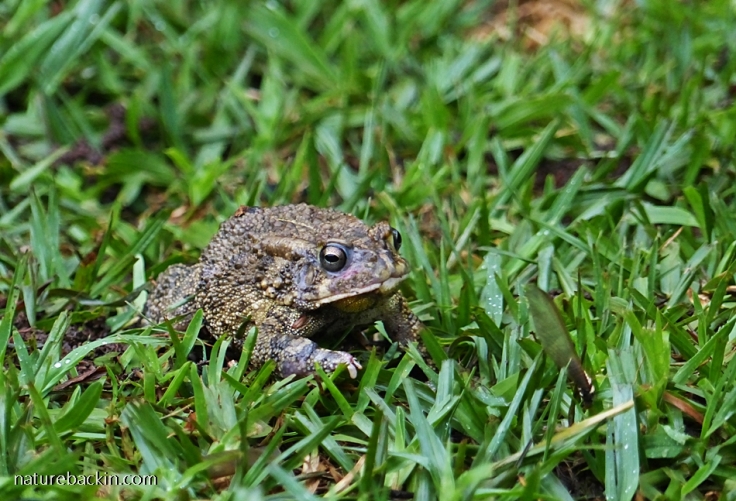
A Guttural Toad out on the lawn hunting flying ants (termites) that emerged after rain
Although invasive in other regions, in our region Guttural Toads occur naturally, although we have noticed a decline in our specific neighbourhood. Years back, especially on misty nights Guttural Toads used to congregate under street lamps in our quiet street to catch insects attracted to the lights. In recent years we almost never see frogs in the street – either alive or dead as a result of being run over, which was a common occurrence before. Although Guttural Toads are adaptable, they also suffer from loss of habitat and are subject to persecution in suburban areas.
In KwaZulu-Natal there is no reason to persecute these animals. That they eat insects, such as mosquitoes, and eat snails and slugs can be viewed as beneficial, and they play a role in our local ecology. The calling of breeding toads and frogs indicates a healthy environment and many people like the sounds that put them in touch with the natural world. Consider that tourists spend a lot of money to go on African safaris and are enchanted by the sounds of frogs and toads calling at night. Compared to loud music and house parties, traffic and leaf blowers, it seems strange that so many people are so intolerant of the calls of frogs and toads.

Last night when more light rain was imminent and the toads and frogs responded with their calling, we went out with a torch and camera to take a look. We interrupted a Guttural Toad who stopped calling due to our presence. He looked rather startled by the torchlight. To the left of the photo a much smaller Clicking Stream Frog can just be seen. The clicking calls of these small frogs is audible most rainy nights in the breeding season
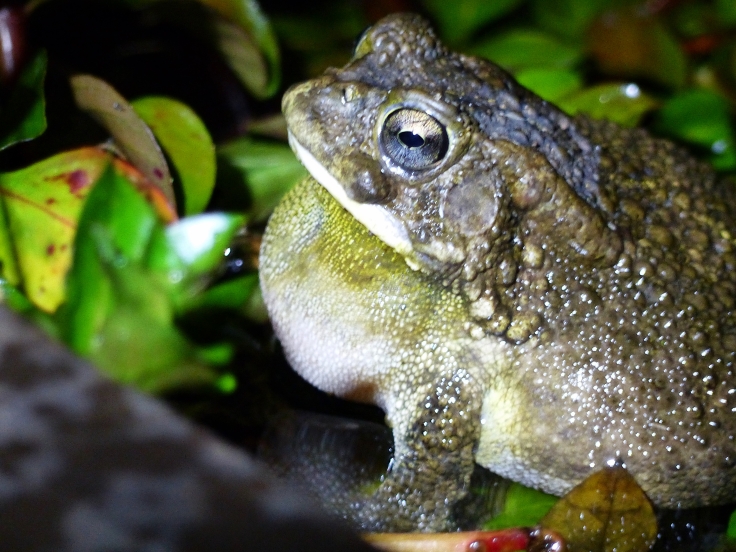
This Guttural Toad could hardly wait for us to leave so it could carry on calling
Females are attracted by the calling of the males. When preparing for the process of mating the male mounts the female and grasps her tightly with his forearms in an embrace known as amplexus (which in fact is Latin for ‘embrace’). In this posture he is positioned to fertilise the eggs as they are expelled from the female’s body into the water.
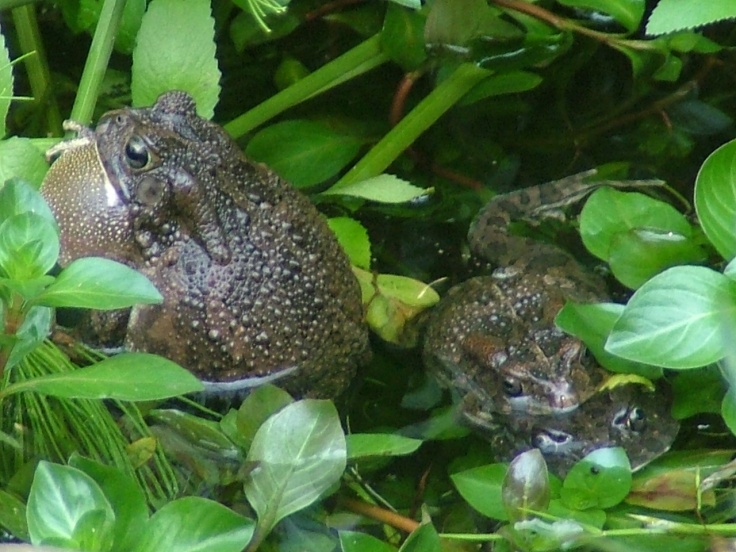
On an overcast morning, a male Guttural Toad was still calling while another male paired up with a female in our garden pond. (This and some other photos in this post and the video were taken in another summer when there was more foliage in the pond than there is currently.)
Breeding can be highly competitive and male toads can seek to dislodge and displace another male that is already coupled with a female. In some instances competition may be so fierce that a ball or tangle of toads can form as males actively try to displace each other and grasp the female. Needless to say this can be very dangerous for females and can result in drownings.
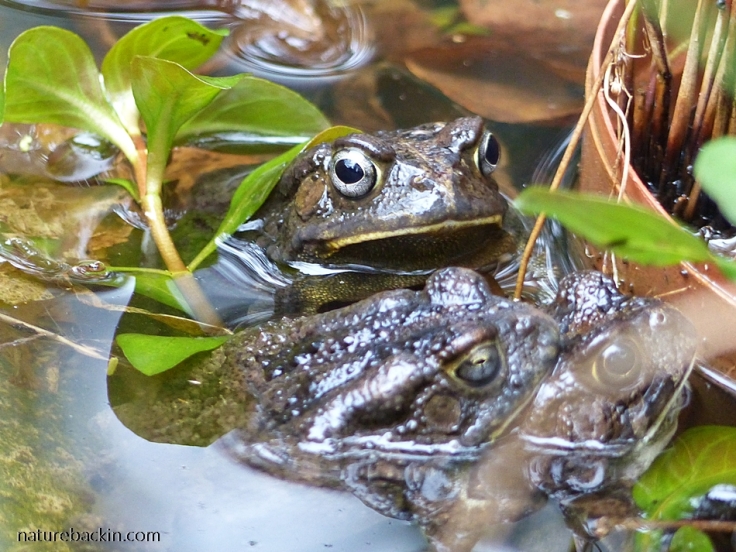
A male Guttural Toad, seemingly glaring at me, is about to try to dislodge another male that is already coupled with a female
In the video below, in the first clip a coupled pair prepares to spawn while another toad provides the soundtrack. In the second clip the spawn can be seen flowing out into the water, the male fertilizing the eggs as they are emitted from the female’s body. In the third clip, a second male has climbed on top of a coupled pair and does his best to dislodge the rival male.
Video of mating Guttural Toads filmed in our garden pond
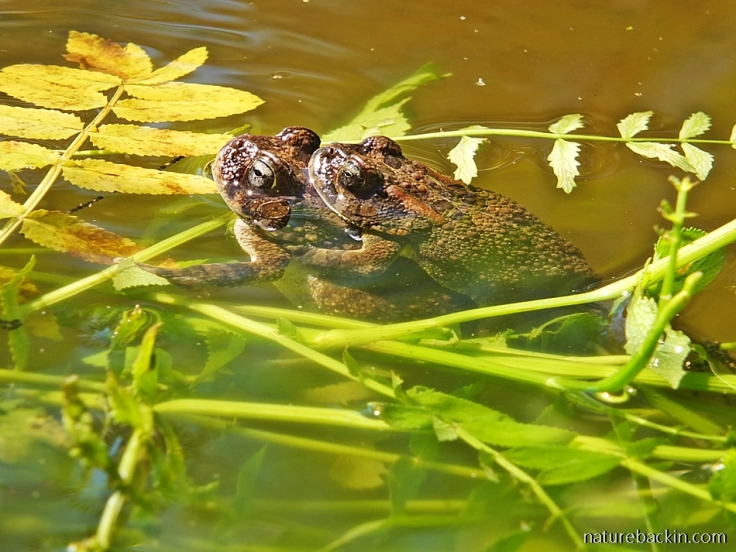
Usually when I have seen Guttural Toads spawning, even when it is busy and there are several couples in the pond, it mostly seems to be a rather benign affair. But little did I know.
Last week on an overcast morning after the busy night before, I visited the pond and found festoons of spawn in the water plus also this pair (below) floating in the pond. I thought there was something a bit odd about the pair. The male had beautiful golden eyes but I wondered if the female with only one cloudy eye visible was blind.
The next day, we found them still in the pond and it dawned on me that in fact the female was dead, although still clasped tightly by the male who was largely submerged. Fearing that the male might be drowning we moved the pair (using a sieve we use to scoop leaves from the surface of the pond) to the shallow end, ensuring that the male’s nose was out of the water. As this was a disturbing sight, I did not take any photographs, but instead went inside to see if I could find any information about frogs and toads mating with a dead partner.
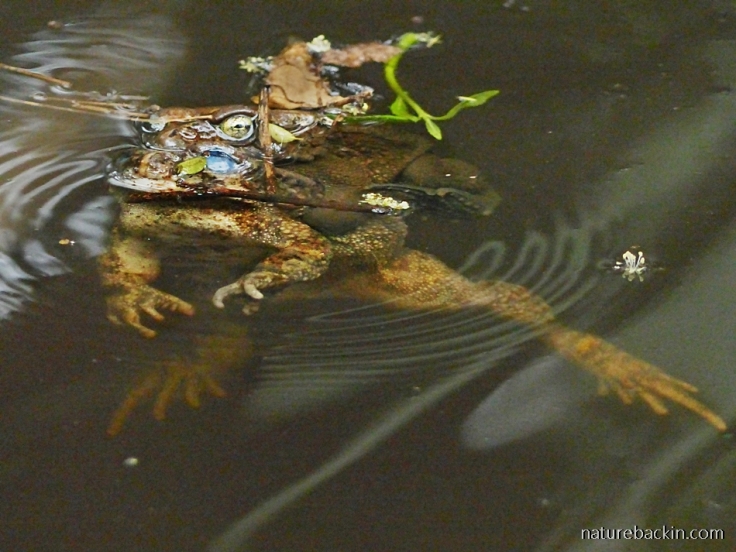
To my surprise I did come across information on some species of frogs and toads – and other species besides – that have been found mating with a dead partner. In the case of some toad species, they have even been found in amplexus with inanimate objects and sometimes also with other species.
Most surprising of all, was that there are recorded incidents of lizards and frogs managing to extract eggs from a dead female’s body and fertilise them. For example, this has been seen in a species of South American frog, Rhinella proboscidea. Field researchers in Brazil observing a male frog clasping a dead female, “saw him squeezing rhythmically, coaxing a string of sticky eggs from her body”. The scientists, in order to confirm if such efforts had been successful collected eggs from “one-sided pairings” and stored them in water-filled plastic bags. As the eggs began to develop they were able to confirm that the males had indeed fertilised the eggs. It is noted that “it is very likely that other frogs engage in similar postmortem reproduction—but acknowledge[d] it will be hard to spot. (For more see https://www.the-scientist.com/notebook/croakus-interruptus-39244)
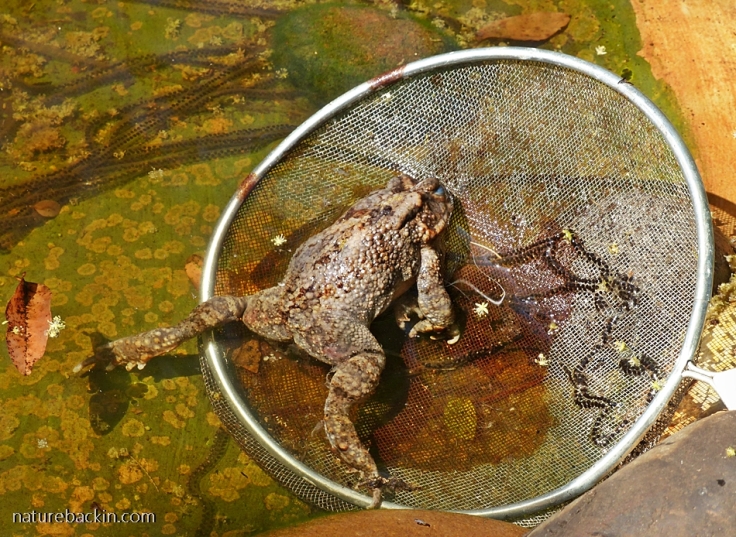
After reading this information I decided to take my camera to record the male frog I had left clasping a dead female on the sieve in the shallow end of the pond. But as I approached I saw the male had gone. To my amazement there was a trail of fresh spawn on the sieve, with a strand of eggs wound around a hind leg of the dead female. It appeared that in my absence when I was looking up the phenomenon, the male had extracted eggs from the dead female. Presumably he had fertilised the eggs in the process before he disappeared from the scene.
I regretted that my squeamishness had prevented me from taking photographs and keeping a better record. Such a mating may not be a rare practice amount Guttural Toads, but it seems records of such an event are rare. We tipped the spawn into the pond to give it a chance of survival and we will never know if it was fertile or not.
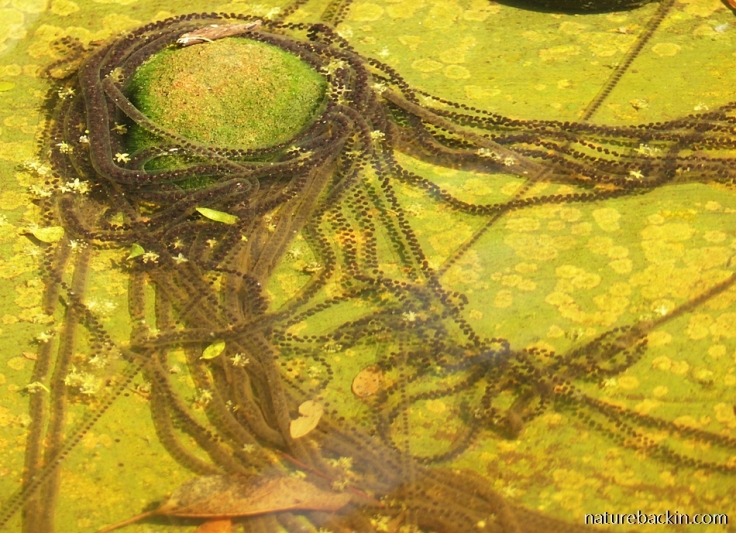
Currently there is not much foliage in the pond, so other pairings of toads used a rock around which to wind some of the spawn
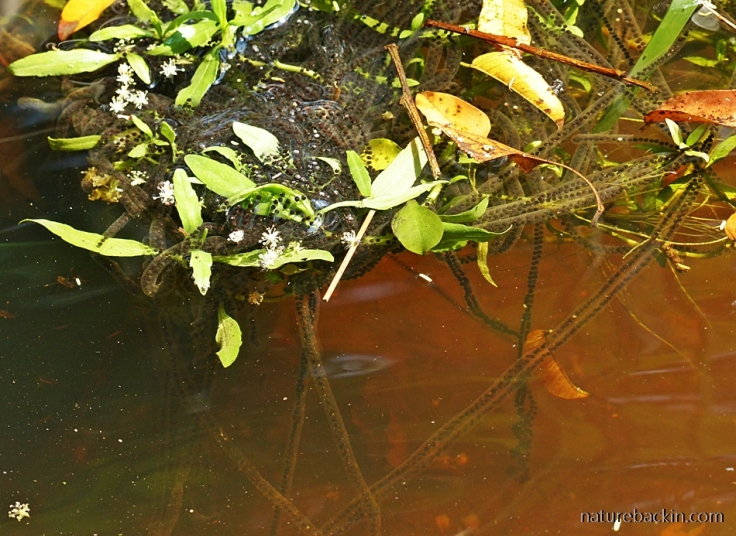
One of the small plants in the pond is also festooned with ropes of spawn
Hopefully the eggs will hatch tadpoles that will eventually develop and transform into frogs. This astonishing metamorphosis underlies the folktales that tell of the extreme transformation of a frog turning into a prince, although I think that the natural phenomenon is miraculous enough as it is.
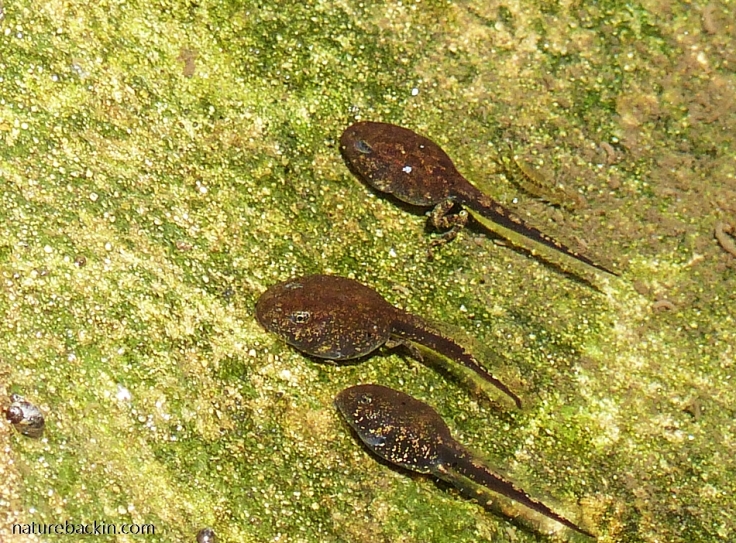
This photo of three tadpoles in our pond (together with a water snail and what might be a tiny damselfly nymph) was taken last summer. These tadpoles are starting to grow hind legs, most noticeable in the tadpole at the top
We value that the tadpoles eat the algae in our pond and also eat mosquito larvae. They also are a source of food for other creatures, such as the fishing spider, and tadpoles themselves are also known to eat each other. From the thousands of eggs laid by the Guttural Toads, only a small percentage survive to hatch as tadpoles, and an even smaller percentage of these survive to develop into froglets, and only a small percentage of these survive to become adults that themselves are potential prey for snakes and other predators. Such is the circle of life when one is a toad.
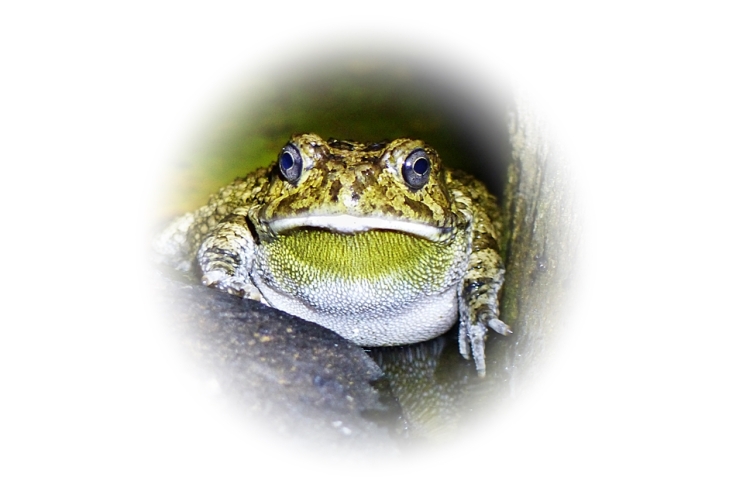
Sources:
Measey, G John. 2011. Ensuring a Future for South Africa’s Frogs: A Strategy for Conservation Research. SANBI Biodiversity Series 9. Pretoria: National Biodiversity Institute. https://www.researchgate.net/publication/259285286_Ensuring_a_future_for_South_Africa’s_frogs_a_strategy_for_conservation_research;
Richards, Sabrina. 2012. Croakus Interruptus. The Scientist. https://www.the-scientist.com/notebook/croakus-interruptus-39244;
Vlok, W, Fouché, PSO, Cook, CL, Wepener, V & Wagenaar, GM. 2013. An assessment of the current distribution, biodiversity and health of frogs of the Kruger National Park in relation to physical and chemical factors. WRC Report no. 1928/1/12. Gezina: Water Research Commission. https://www.researchgate.net/publication/262913308_An_assessment_of_the_current_distribution_biodiversity_and_health_of_the_frogs_of_the_Kruger_National_Park_in_relation_to_physical_and_chemical_factors
Posted by Carol









September 13, 2019 at 6:50 pm
I love hearing frogs in the garden! Your pictures are marvellous!
LikeLiked by 1 person
September 14, 2019 at 8:27 pm
Glad to know you also enjoy hearing frogs in the garden 🙂 Tonight I can only hear the clicking of the stream frogs – it is somehow a comforting sound to hear.
LikeLiked by 1 person
September 16, 2019 at 8:43 am
I love all the different sounds of the frogs. We also have the Foam nest frogs here. It always sound as if they are singing a song rather than croaking, very chirpy.
LikeLiked by 1 person
September 8, 2019 at 10:15 am
Wonderful post Carol! I was already mesmerised by the video clips but learning about the one-sided pairing is astonishing. I wonder if the dead female you observed had drowned thanks to the males competing for her.
LikeLiked by 1 person
September 11, 2019 at 6:28 pm
Thank you Sandra. I was also wondering if drowning had caused her death – I should think that the most likely cause. I saw only three other toads in the pond the first morning I saw her, but there could have been more going on during the previous night.
LikeLiked by 1 person
September 8, 2019 at 9:34 am
What a riveting post. I confess that I find the Guttural Toad ugly and thought it to be aptly named! Its call on the other hand is beautiful. I was surprised when I listened to your clip at how lyrical the sound is, as I was expecting a guttural sound
As for postmortem fertilisation… I am gobsmacked!
LikeLiked by 1 person
September 11, 2019 at 6:24 pm
Yes, I was astonished too.
After several days with just the Stream Clicking Frogs calling, the Guttural Toads have tuned up tonight – we are hoping that is in anticipation of more rain. I so do hope that you get some decent rain soon.
LikeLiked by 1 person
September 6, 2019 at 7:15 pm
What an amazing discovery and narration. You are quite the observer of what goes on in your little corner of the planet.
We have noticed that the frogs are completely absent in our yard where there were quite a few in past years. They are very much missed and we’re not quite sure why they seem to be gone. On the other hand, we have quite a number of baby lizards. We’ve just recently spotted some babies which are astonishingly tiny when first hatched. I’m learning the sound of their ‘singing’ when the first signs of moisture appear. Their songs before the first sprinkle we had not long ago sounds much like crickets. What a joy it is to live where we can observe some of this circle of life.
Thanks ever so much for this inspiration to more closely observe our natural world.
LikeLiked by 1 person
September 7, 2019 at 2:17 pm
Thanks Gunta. That is puzzling about the absent frogs – hopefully they will be about in a future season?
I am fascinated to hear about your chirruping lizards. Do you know the name of the species?
I am constantly amazed by what one can find if one stops to look, and I am finding that I am slowly learning to “see” in new and rewarding ways, but there must be so much that I am completely oblivious of nonetheless!
LikeLike
September 9, 2019 at 2:20 am
I’m told by the ‘resident expert’ that it’s a western fence lizard. I think I posted pictures of one recently. If I find the time, I can post a baby lizard shot and our blue tailed skink with their fluorescent blue tails, that I’m told they sacrifice if a predator grabs it. It’s amazing stuff!
LikeLiked by 1 person
September 11, 2019 at 6:49 pm
Thanks Gunta. Yes that tail shedding and the ability to regrow a tail is amazing.
LikeLike
September 6, 2019 at 2:12 pm
Fascinating. I love how your careful observations reveal such treasures – right in suburbia.
LikeLiked by 2 people
September 7, 2019 at 2:12 pm
Thank you Nikki. We are fortunate that our suburban environment still has a measure of diversity present. It is my hope that more suburbanites value this and actively try to provide sanctuary and habitat!
LikeLiked by 2 people
September 6, 2019 at 6:40 am
Great post and photos, as always, Carol. I like the calling of the frogs and toads around here, though the coqui frog, which is extremely loud, is an invasive species doing disturbingly well. I was hearing them quite regularly for a while, but not so much lately so perhaps the local coqui coalition has eradicated them. They have become well established elsewhere on the island, to the detriment of some of the indigenous frogs.
LikeLiked by 1 person
September 7, 2019 at 2:10 pm
Thank you Graham. Those invasive species are a problem through no fault of their own. It is harsh that they need to be eradicated to protect native species.
We humans do pick and choose what to actively encourage, tolerate or eradicate – and sometimes the judgements that ensue can be rather contradictory and confusing!
LikeLiked by 1 person
September 9, 2019 at 6:30 am
Well, humans are the biggest problem in all this, that’s for sure.
LikeLiked by 1 person
September 6, 2019 at 5:01 am
A read worth looking forward to – you are a marvellous recorder of nature in your garden! So far there are no frog / toad calls to brighten our spring nights for the dam below our home is bone dry as are the gardens around us. They will return with the first rains, for it is amazing how these creatures are able to wait out the dry conditions.
LikeLiked by 1 person
September 7, 2019 at 2:06 pm
Thank you Anne and it is amazing how amphibians can survive dry conditions, although prolonged droughts do take their toll. I really am hoping that your region gets rain soon and you can hear that the toads and frogs are once again viable.
LikeLike
September 6, 2019 at 3:27 am
Wow, Carol, what a gem of a post this is! Thoroughly informative and enjoyable, and recording some pretty amazing behaviour too. Thank you very, very much!
Since moving into our new townhouse 5 years ago we haven’t heard a toad calling outside our windows even once; it was a regular and very welcome serenade at our previous home.
LikeLiked by 1 person
September 7, 2019 at 1:37 pm
Thanks very much Dries. I learnt a whole lot about animal behaviour after encountering that bizarre (to our eyes) couple. It is nice to be able to share what I come across, and it also encourages me to try to find out more.
It is sobering that you do not hear any toads where you live now. I wonder if the fact that so many people choose to have pretty much sterile surroundings is a contributory factor.
LikeLiked by 1 person
September 8, 2019 at 5:09 pm
I’m keeping an eye open for toads crossing the public roads here in the neighbourhood when it rains so that I can relocate one or two to our garden. I don’t rake away the dead leaves beneath our honeysuckles and its amazing to see the earthworm population blossoming as a result, so there’s plenty of food here to welcome the toads when they arrive.
LikeLiked by 1 person
September 6, 2019 at 1:31 am
Another great post, Carol. I love hearing the different species of frogs and toads calling in the spring and early summer here. I used to have a small pond in front of our house where for several years frogs would spawn. One year, I was horrified that several amorous males had mobbed a female and drowned her. So harsh!
LikeLiked by 1 person
September 7, 2019 at 1:32 pm
Not a nice aspect to encounter. For most species it is perhaps the exception rather than the rule, although the the mortality rate is high due to many other factors. Nevertheless frogs and toads have an important role to play, and from a human point of view their calls and chorusing add a rich dimension to spring and summertime. Lovely to hear as you say.
LikeLiked by 1 person
September 5, 2019 at 9:34 pm
Oh my, what a trip down memory lane. We had an old cement lined pool at our grandparents, that went downhill rapidly one summer…. Somehow there were tadpoles introduced, and every time we’d go there. My parents always found me in the middle of the pool chasing the tadpoles. Lol, ohh my! Thanks for the reminder! Great and informative post!
LikeLiked by 1 person
September 7, 2019 at 1:13 pm
Glad to trigger such memories! Pond life can be fascinating even for adults 🙂
LikeLiked by 1 person
September 5, 2019 at 7:49 pm
What a fascinating post. And wonderful that you have made such detailed observations. At our last house we had a small pond, and seeing up to 20 or 30 common frogs crammed into this tiny pool of water, mating was one of the wonders of springtime. That and their constant croaking.
LikeLiked by 1 person
September 5, 2019 at 8:02 pm
Thanks Margaret. What a sight (and sound!) to have had so many frogs in a small pond! The most pairs of toads we have had at any one time in our pond is 4 or 5 – although it sounds like a lot more. With the smaller shyer frogs its hard to know.
LikeLike
September 6, 2019 at 2:46 pm
Oh it was madness. It was like the January sales in there! and deliciously noisy too.
LikeLiked by 1 person
September 7, 2019 at 2:12 pm
What a fantastic analogy 🙂
LikeLiked by 1 person